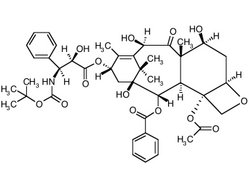Abstract
Chemotherapeutic agents may induce a wide variety of adverse mucocutaneous effects, including nail changes. We present a case of atypical onycholysis, associated with subungual abscess formation, paronychia and pyogenic granuloma resulting from the use of mitozantrone, an antineoplastic cytotoxic agent, in the treatment of metastatic prostate cancer.
**********
Case Report
An 82-year-old male was referred by the oncology department to our clinic for unusual nail changes. He had no significant past medical history apart from a high grade metastatic prostate adenocarcinoma (Gleason 8/8). After failure to improve on bicalutamide (Casodex[R]) and goserelin acetate (Zoladex[R]) therapy, a combination of prednisone and mitozantrone (Novatrone[R], Onkotrone[R]) was initiated. The treatment was well-tolerated, leading to a decline in the PSA level. After 12 weeks (4 cycles) of mitozantrone, the patient noted a yellowish discoloration of most of the nails on his hands and feet, and complained of painful separation of his toenails.
On physical examination, diffuse erythematous swelling with tenderness was observed on all the fingers extending to the distal interphalangeal joints. There was yellow discoloration of all the nails, with obvious onycholysis of the toenails. Subungual hemorrhage and a seropurulent periungual discharge were also noted on the distal nail fold of several toes, most severely affecting the big toes (Figures 1 and 2). Examination of the patient's fingernails revealed marked dusky erythema and edema of the periungual tissue, with papules of granulation tissue involving the lateral nail folds (Figure 3). No other mucocutaneous lesions, including alopecia, were present. Culture swabs of periungual discharge grew 1+ Staphylococcus aureus.
Discussion
Mitozantrone (also spelled mitoxantrone) is an anthracenedione cytotoxic agent commonly used in the treatment of breast, prostate, and hepatocellular cancer, as well as a number of hematological malignancies. A derivative of doxorubicin, mitozantrone is usually well-tolerated and has a low incidence of adverse reactions. Whereas alopecia is known to occur in a number of patients, other mucocutaneous effects are relatively rare. A literature search revealed several reports linking mitozantrone to discoloration of the nails and onycholysis, (1-7) however, the seropurulent exudate, periungual inflammation, and pyogenic granuloma-like changes seen on most of the finger nails have not, to our knowledge, been previously reported in association with mitozantrone.
Interestingly, painful hemorrhagic onycholysis, seropurulent discharge and acute paronychia have been observed with the use of docetaxel chemotherapy, and have been attributed to subungual abscess formation, (8-11) which would account for the yellow discoloration of our patient's nails. As well, the periungual inflammation and pyogenic granuloma-like lesions in the presented case resemble changes reported in association with oral and topical retinoid therapy, and more recently with protease-inhibitors. (12-15) It has been proposed that the mechanism of chemotherapy-induced onycholysis is secondary to the direct cytotoxicity on the mitotic activity in the nail matrix, and is thus analogous to anagen effluvium of the scalp. Furthermore, onycholysis in patients receiving certain cytotoxic drugs, especially anthracyclines (which are structurally related to mitozantrone) may be increased by exposure of the hyponychium to sunlight, with subsequent phototoxicity, and patients have been advised to avoid sun exposure of their toe and fingernails. (16)
[FIGURE 1 OMITTED]
[FIGURE 2 OMITTED]
[FIGURE 3 OMITTED]
While onycholysis and described changes may not be life-threatening chemotherapy-induced complications, these may facilitate the development of secondary infection, which is potentially serious in an immunocompromised patient. In the presented case, the patient had not been advised of these potential side effects, and was much frustrated by the pain and discomfort. We believe that mitozantrone-induced nail changes are a phenomenon that might be overlooked and underreported. Clinicians should be aware this potential side effect and counsel their patients accordingly.
References
1. Creamer JD, Mortimer PS, Powles TJ. Mitozantrone-induced onycholysis. A series of five cases. Clin Exp Dermatol. 1995;20(6):459-61.
2. Makris A, Mortimer P, Powles TJ. Chemotherapy-induced onycholysis. Eur J Cancer. 1996;32A(2):374-5.
3. Mitchell PL, Harvey VJ. Mitozantrone-induced onycholysis. Eur J Cancer. 1992;28(1):243-4.
4. Scheithauer W, Ludwig H, Kotz R, Depisch D. Mitoxantrone-induced discoloration of the nails. Eur J Cancer Clin Oncol. 1989;25(4):763-5.
5. Seminara P, Franchi F, Codacci-Pisanelli G, Aronne T, Abdolrahim zadeh S. Discoloration of the nails and early anemia after mitoxantrone, folinic acid and 5-fluorouracil. Med Oncol Tumor Pharmacother. 1990;7(4):291-2.
6. Speechly-Dick ME, Owen ER. Mitozantrone-induced onycholysis. Lancet. 1988;1(8577):113.
7. Van Belle SJ, Dehou MF, De Bock V, Volckaert A. Nail toxicity due to the combination adriamycin-mitoxantrone. Cancer Chemother Pharmacol. 1989;24(1):69-70.
8. Nicolopoulos J, Howard A. Docetaxel-induced nail dystrophy. Australas J Dermatol. 2002;43(4):293-6.
9. Vanhooteghem O, Andre J, Vindevoghel A, Vandenbossche L, Vandeveire A, Song M. Docetaxel-induced subungual hemorrhage. Dermatology. 1997;194(4):419-20.
10. Minisini AM, Tosti A, Sobrero AF, Mansutti M, Piraccini BM, Sacco C, et al. Taxane-induced nail changes: incidence, clinical presentation and outcome. Ann Oncol. 2003;14(2):333-7.
11. Vanhooteghem O, Richert B, Vindevoghel A, Vandenbossche L, Vandeveire A, de la Brassinne M. Subungual abscess: a new ungual side-effect related to docetaxel therapy. Br J Dermatol. 2000;143(2):462-4.
12. Blumental G. Paronychia and pyogenic granuloma-like lesions with isotretinoin. J Am Acad Dermatol. 1984;10(4):677-8.
13. Baran R. Pyogenic granuloma-like lesions associated with topical retinoid therapy. J Am Acad Dermatol. 2002;47(6):970.
14. Pierson JC, Owens NM. Pyogenic granuloma-like lesions associated with topical retinoid therapy. J Am Acad Dermatol. 2001;45(6):967-8.
15. Sass JO, Jakob-Solder B, Heitger A, Tzimas G, Sarcletti M. Paronychia with pyogenic granuloma in a child treated with indinavir: the retinoid-mediated side effect theory revisited. Dermatology. 2000;200(1):40-2.
16. Hussain S, Anderson DN, Salvatti ME, Adamson B, McManus M, Braverman AS. Onycholysis as a complication of systemic chemotherapy: report of five cases, associated with prolonged weekly paclitaxel therapy and review of the literature. Cancer. 2000;88(10):2367-71.
Anatoli Freiman MD, Nathaniel Bouganim MD, Elizabeth A. O'Brien MD FRCPC
Division of Dermatology, McGill University, Montreal, Canada
Address for Correspondence
Anatoli Freiman, MD
Division of Dermatology
McGill University Health Centre
687 Pine Ave West, Rm A4.17
Montreal, Qc, H3A1A1 Canada
Phone: 514-285-9385
Fax: 514-843-1570
e-mail: anatoli.freiman@sympatico.ca
COPYRIGHT 2005 Journal of Drugs in Dermatology, Inc.
COPYRIGHT 2005 Gale Group



